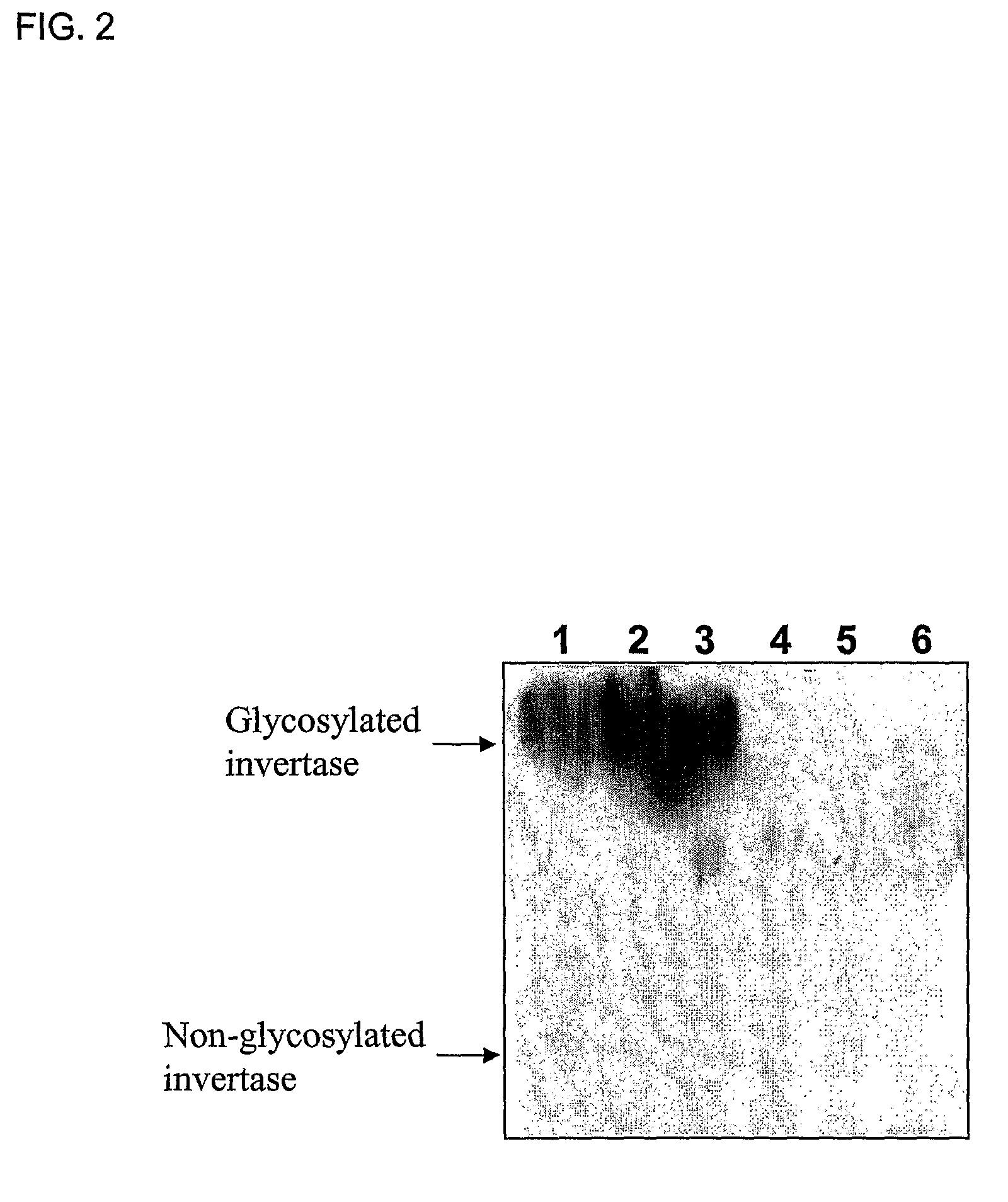Library of translational fusion partners for producing recombinant proteins and translational fusion partners screened therefrom
a technology of translational fusion partners and recombinant proteins, applied in the field of recombinant protein expression, can solve the problems of little or no protein expression and secretion, and no general technique that is effective for secretory production of all proteins, and achieves rapid and efficient automatic screening
- Summary
- Abstract
- Description
- Claims
- Application Information
AI Technical Summary
Benefits of technology
Problems solved by technology
Method used
Image
Examples
example 1
Preparation of Invertase-Deficient Yeast Mutant
[0136]For rapid screening of the translational fusion partners (TFP) of non-producible proteins, an automatic screening system was established through the evaluation of cell growth in a sucrose medium using yeast invertase as a reporter.
[0137]A yeast strain having no invertase activity was required to use an invertase gene as a reporter for the positive screening of useful TFP. Thus, the chromosomal SUC2 gene of wild type yeast was deleted. In order to prepare a SUC2 deletion cassette, a plasmid pRB58 (Carlson et al., Cell 20:145 (1982)) was digested with EcoRI and XhoI, and a SUC2 coding gene was recovered and introduced into EcoRI-XhoI sites of pBluescript KS+ (Stratagene, USA), thus generating pBIΔBX. As shown in FIG. 1, an URA3 gene having a repeat sequence of 190 bp (Tc190) (Bae et al., Yeast 21:437 (2004)) at both ends was inserted into HindIII-XbaI sites of the SUC2 gene contained in pBIΔBX, thus generating pBIU. The pBIU was dig...
example 2
Development of Automatic Screening System Using an Invertase as a Secretion Reporter
[0140]The invertase deficient strain was evaluated for the possibility of being automatically screened in a sucrose medium through the expression of a protein fused to invertase, using two human therapeutic proteins, a human serum albumin (HSA) which is well secreted in yeast, and a human interleukin-2 (IL-2) which is hardly secretable in yeast.
[0141]Three plasmids, pYGAP-SNS-SUC2, pYGAP-HSA-SUC2 and pYGAP-hIL2-SUC2, were constructed to test for automatic selection on sucrose media. For the construction of pYGAP-SUC2 containing an invertase, gene (SUC2, YIL162W) expression cassette under the control of the yeast GAPDH promoter, pST-SUC2 was constructed first by subcloning a PCR product containing SUC2 gene amplified from pBIΔBX (FIG. 1) using primers SUC-F (SEQ ID NO. 1) and SUC-R (SEQ ID NO. 2) into pST-Blue-1 (Novagen, USA). PCR was carried out with Pfu polymerase (Stratagene, USA) or Ex-Taq DNA po...
example 3
Preparation of Vectors for the Construction of Translational Fusion Partner (TFP) Library
[0143]Several vectors were designed for the construction of a TFP library from genomic DNA or a cDNA library from any source. For the construction of a TFP library from cDNA, a plasmid YGaINV was constructed (FIG. 6). A PCR was carried out to amplify a DNA fragment encoding invertase from pYGAP-hIL2-SUC2 using two PCR primers, SfiI-SUC-F (SEQ ID NO:10) and SUC-Xho-R (SEQ ID NO:11). PCR conditions included one cycle of 94° C. for 5 min, and 25 cycles of 94° C. for 30 sec, 55° C. for 30 sec and 72° C. for 2 min, followed by one final cycle of 72° C. for 7 min. Then an EcoRI-SalI digested PCR fragment was ligated to EcoRI-SalI digested YEGα-HIR525 and the resulting plasmid was named YGaINV (FIG. 6). For the construction of a TFP library from partially digested genomic DNA, three vectors, YGaF0INV, YGaF1INV and YGaF2INV, each containing one of three different reading frames of the SUC2 gene were con...
PUM
| Property | Measurement | Unit |
|---|---|---|
| pH | aaaaa | aaaaa |
| pH | aaaaa | aaaaa |
| pH | aaaaa | aaaaa |
Abstract
Description
Claims
Application Information
 Login to View More
Login to View More - R&D
- Intellectual Property
- Life Sciences
- Materials
- Tech Scout
- Unparalleled Data Quality
- Higher Quality Content
- 60% Fewer Hallucinations
Browse by: Latest US Patents, China's latest patents, Technical Efficacy Thesaurus, Application Domain, Technology Topic, Popular Technical Reports.
© 2025 PatSnap. All rights reserved.Legal|Privacy policy|Modern Slavery Act Transparency Statement|Sitemap|About US| Contact US: help@patsnap.com



